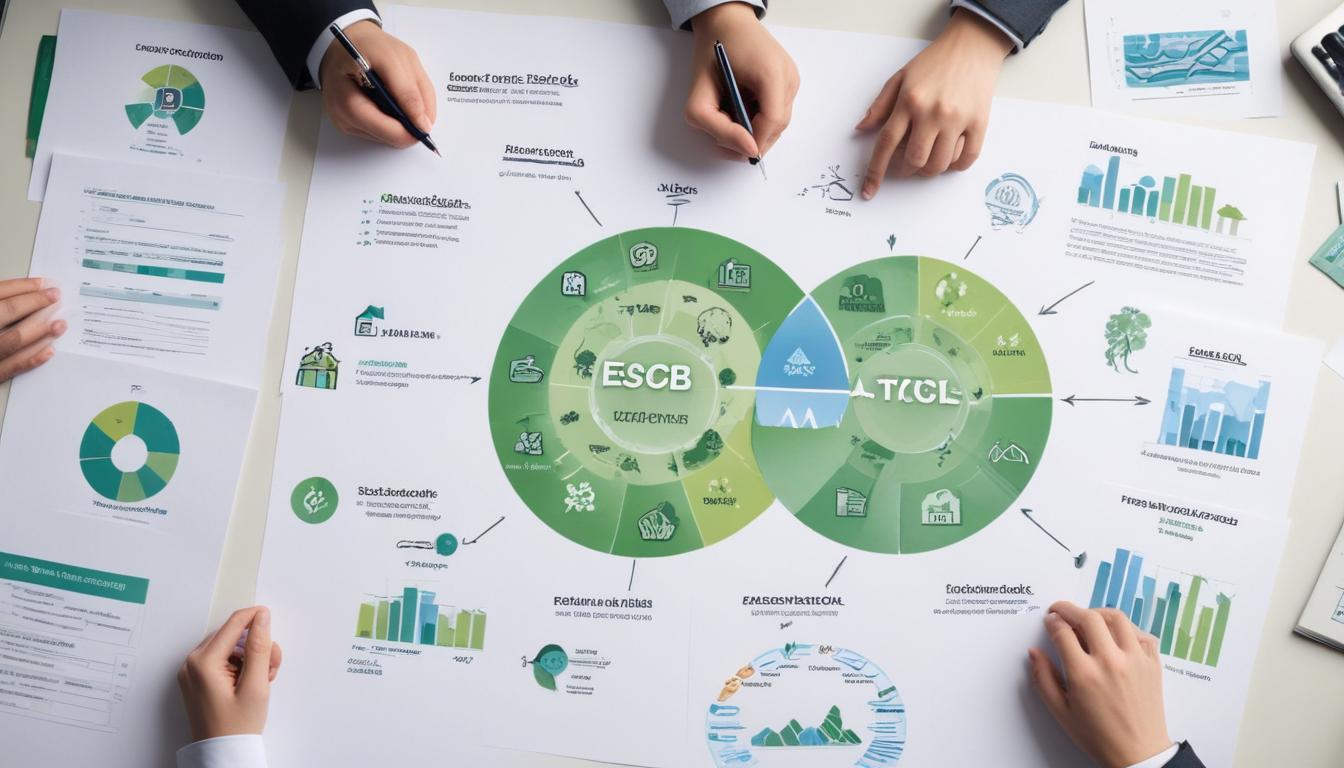ESG analysis evaluates environmental, social, and governance factors, enabling companies to identify risks and opportunities, enhance transparency, and meet regulatory requirements, while leveraging technologies like AI for improved accuracy in reporting and future sustainability strategies.
Have you ever wondered how esg analysis influences investment strategies and corporate responsibility? This article sheds light on the key tools and techniques that drive meaningful change.
What tools are essential for effective ESG analysis?
Effective ESG analysis requires a diverse set of tools that help organizations assess their environmental, social, and governance impacts. Understanding which tools are essential can significantly enhance the accuracy and reliability of the analysis.
One of the key tools is data management software, which aids in the collection and processing of vast amounts of data related to ESG metrics. This software can sort and analyze data from various sources, making it easier to draw meaningful insights.
Additionally, benchmarking tools are vital for comparing a company’s ESG performance against industry standards or peers. By establishing benchmarks, businesses can identify areas for improvement and set realistic sustainability goals.
Another essential tool is the risk assessment framework. This framework allows companies to analyze potential ESG risks, assisting in the development of strategies to mitigate those risks effectively. Such proactive measures can safeguard against potential financial losses and reputational damage.
Furthermore, reporting frameworks like the Global Reporting Initiative (GRI) and the Sustainability Accounting Standards Board (SASB) provide structured guidelines for presenting ESG performance. Utilizing these frameworks ensures transparency and consistency in reporting, which is crucial for stakeholder trust.
To summarize, here are the primary tools essential for effective ESG analysis:
- Data management software for efficient data processing;
- Benchmarking tools for industry comparisons;
- Risk assessment frameworks for identifying potential ESG risks;
- Reporting frameworks for standardized disclosures.
Utilizing these tools not only improves the depth and breadth of ESG analysis but also supports organizations in fostering a culture of sustainability and accountability.
How do techniques in ESG analysis shape investment decisions?
The techniques used in ESG analysis play a crucial role in influencing investment decisions. By evaluating environmental, social, and governance factors, investors can align their portfolios with sustainable practices that reflect their values.
One significant technique is the use of quantitative metrics, which allows investors to assess performance based on concrete data. Metrics such as carbon emissions reduction, diversity in leadership, or community engagement can provide valuable insights into a company’s ESG standing.
Additionally, qualitative assessments help investors understand the potential risks and opportunities present in ESG factors. This includes evaluating corporate governance structures, ethical practices, and stakeholder engagement, which are not easily quantifiable but equally important.
Another effective technique is the implementation of scenario analysis. This method assesses how different ESG factors could impact a company’s financial future under various scenarios. It enables investors to visualize potential outcomes, aiding in informed decision-making.
Furthermore, engaging with a company through shareholder advocacy allows investors to influence corporate policies and practices directly. By advocating for better ESG compliance, shareholders can push companies towards more sustainable operations.
To sum up, here are the essential techniques in ESG analysis that shape investment decisions:
- Quantitative metrics for objective performance evaluation;
- Qualitative assessments for understanding broader risks;
- Scenario analysis to predict future impacts;
- Shareholder advocacy to influence corporate practices.
Incorporating these techniques fosters a more responsible investment landscape, encouraging companies to prioritize sustainability.
Key frameworks for conducting thorough ESG analysis

Understanding the key frameworks for conducting thorough ESG analysis is essential for organizations aiming to enhance their sustainability practices. These frameworks provide structured approaches to assess a company’s environmental, social, and governance performance.
One prominent framework is the Global Reporting Initiative (GRI), which offers guidelines for organizations to prepare sustainability reports. The GRI framework emphasizes transparency and accountability, helping companies disclose their impacts on various stakeholders.
Another important framework is the Sustainability Accounting Standards Board (SASB), which focuses on financially material sustainability information. SASB standards provide specific metrics and disclosures tailored to different industry sectors, enabling investors to understand the ESG risks and opportunities that could affect financial performance.
The Task Force on Climate-related Financial Disclosures (TCFD) is also crucial, providing recommendations for companies to disclose climate-related financial risks. This framework helps businesses understand how climate change might impact their operations and guide them in reporting these risks effectively.
Additionally, the ISO 26000 framework offers guidance on social responsibility, covering a wide range of topics from human rights to consumer issues. It helps organizations integrate social responsibility into their strategies and operations.
To summarize, here are the key frameworks for conducting thorough ESG analysis:
- Global Reporting Initiative (GRI) for sustainability reporting;
- Sustainability Accounting Standards Board (SASB) for financial materiality;
- Task Force on Climate-related Financial Disclosures (TCFD) for climate risk assessment;
- ISO 26000 for guidance on social responsibility.
Utilizing these frameworks not only enhances the quality of ESG assessments but also fosters greater trust among investors and stakeholders.
The role of technology in enhancing ESG analysis accuracy
Technology plays a critical role in enhancing the accuracy of ESG analysis, enabling organizations to obtain more reliable data and insights. By leveraging various technological innovations, companies can streamline their analysis processes and improve decision-making.
One of the most significant advancements is the use of data analytics software. This technology allows organizations to process large volumes of ESG-related information rapidly, helping them identify trends and patterns that might be missed otherwise. With advanced analytics, businesses can make data-driven decisions that align with their sustainability goals.
Moreover, artificial intelligence (AI) is transforming ESG analysis by providing predictive capabilities. AI algorithms can analyze historical data and forecast potential ESG risks, assisting companies in proactively addressing these challenges before they escalate. This predictive nature of AI enhances the overall accuracy of assessments.
Blockchain technology also contributes significantly by ensuring transparency and traceability in ESG data. It allows organizations to verify the authenticity of claims related to sustainability practices, which builds trust among stakeholders. By utilizing blockchain, companies can provide credible evidence of their ESG commitments.
Furthermore, digital reporting tools simplify the process of disclosing ESG performance. These tools facilitate real-time reporting and help organizations adhere to evolving regulatory requirements. By using digital platforms, companies can present their ESG data more clearly and effectively.
In summary, technology enhances ESG analysis accuracy through:
- Data analytics software for rapid information processing;
- Artificial intelligence for predictive risk assessment;
- Blockchain for transparency and traceability;
- Digital reporting tools for clear disclosures.
Integrating these technologies into ESG practices not only boosts accuracy but also supports organizations in achieving their sustainability objectives.
Real-world applications of ESG analysis in various sectors
Exploring the real-world applications of ESG analysis across various sectors reveals how businesses leverage this framework to enhance sustainability and improve performance. ESG analysis is not just theoretical; it actively shapes corporate strategies and operations.
In the energy sector, for instance, companies are using ESG analysis to assess their carbon footprints and develop cleaner energy sources. By evaluating environmental impacts, they can identify opportunities for reducing emissions and transitioning towards renewable energy options.
The finance sector is also increasingly embracing ESG principles. Financial institutions assess the ESG performance of companies they invest in, influencing their lending and investment decisions. This practice helps to mitigate risk and promotes responsible investing, aligning financial outcomes with ethical considerations.
In the manufacturing industry, firms use ESG analysis to improve operational efficiency and resource management. By addressing social factors such as labor practices and community engagement, businesses can enhance their reputation and ensure compliance with regulations.
In the technology sector, ESG analysis drives innovation by encouraging tech companies to focus on ethical data practices and sustainable product development. Companies that prioritize ESG considerations often gain a competitive edge, appealing to consumers who value sustainability.
To summarize, here are key sectors where ESG analysis finds practical applications:
- Energy sector: Assessing carbon footprints and developing renewable energy.
- Finance sector: Influencing investment decisions through ESG performance evaluations.
- Manufacturing industry: Improving efficiency and labor practices.
- Technology sector: Driving innovation through ethical data handling and sustainable practices.
By integrating ESG analysis, organizations across these sectors can contribute to a sustainable future while simultaneously enhancing their operational resilience and market competitiveness.
Future trends in ESG analysis and sustainability practices

Exploring future trends in ESG analysis and sustainability practices reveals how organizations will adapt to increasing demands for transparency and responsibility. As global awareness of environmental and social issues grows, companies must continually evolve their strategies.
One significant trend is the greater integration of artificial intelligence (AI) and machine learning into ESG analysis. These technologies allow for more sophisticated data analysis, enabling organizations to identify trends and risks more accurately. By harnessing predictive analytics, companies can anticipate potential ESG issues before they arise.
Another trend is the rise of regulatory frameworks that emphasize accountability. Governments and regulatory bodies are increasingly mandating disclosures related to ESG metrics, compelling organizations to provide more detailed and accurate reports. This shift is expected to enhance investor confidence and foster greater corporate responsibility.
The incorporation of stakeholder engagement into ESG strategies will also become more pronounced. Companies are recognizing the importance of collaborating with stakeholders, including communities and advocacy groups, to develop sustainable practices that align with societal expectations.
Additionally, there is an expected growth in the demand for green finance products, such as green bonds and sustainable investment funds. Investors are looking for opportunities that not only yield financial returns but also contribute positively to environmental and social outcomes.
To summarize, here are the key future trends in ESG analysis and sustainability practices:
- Integration of AI and machine learning for enhanced data analysis;
- Stricter regulatory frameworks mandating detailed ESG disclosures;
- Increased emphasis on stakeholder engagement in sustainability practices;
- Growth in demand for green finance products.
Organizations that proactively embrace these trends will be better positioned to thrive in an increasingly sustainability-focused landscape.
In conclusion, the evolving landscape of ESG analysis and sustainability
The world of ESG analysis is rapidly changing as businesses and investors recognize the importance of sustainable practices. With technology advancing and regulatory requirements increasing, companies must adapt to remain competitive and responsible.
By embracing trends like artificial intelligence, stakeholder engagement, and green finance, organizations can enhance their ESG strategies and create positive impacts both socially and environmentally. As these practices become more integrated into everyday business models, companies will not only meet the expectations of consumers and investors but also contribute to a healthier planet.
Thus, it is clear that a commitment to ESG and sustainability is not only beneficial but essential for long-term success.
Common Questions About ESG Analysis and Sustainability
How does ESG analysis benefit companies?
ESG analysis helps companies identify risks and opportunities related to environmental, social, and governance factors. For instance, a business focusing on sustainable practices can enhance its reputation and attract investors interested in ethical investments, ultimately driving long-term success.
What role does technology play in ESG analysis?
Technology, such as AI and data analytics, enhances the accuracy of ESG analysis by enabling faster and more comprehensive data processing. For example, AI can predict potential sustainability risks, helping companies proactively address them before they become issues.
Are there specific frameworks for conducting ESG analysis?
Yes, several frameworks guide ESG analysis, such as the Global Reporting Initiative (GRI) and the Sustainability Accounting Standards Board (SASB). These frameworks provide structured guidelines for companies to report their ESG performance, promoting transparency and accountability.
What are some future trends in ESG practices?
Future trends include increased reliance on artificial intelligence for data analysis and greater regulatory scrutiny of ESG disclosures. Companies will also likely prioritize stakeholder engagement and develop more green financial products to appeal to socially conscious investors.
How can companies implement effective ESG strategies?
To implement effective ESG strategies, companies should assess their current practices, set measurable goals, and engage stakeholders. An example is a business creating a sustainability committee to oversee its initiatives, ensuring that it aligns with both investor expectations and community interests.
What challenges might companies face in ESG reporting?
Companies may encounter challenges such as data collection and the need for transparency in disclosures. For instance, accurately measuring carbon footprints can be complex due to varying data quality across different departments. Addressing these challenges is crucial for genuine ESG reporting.


